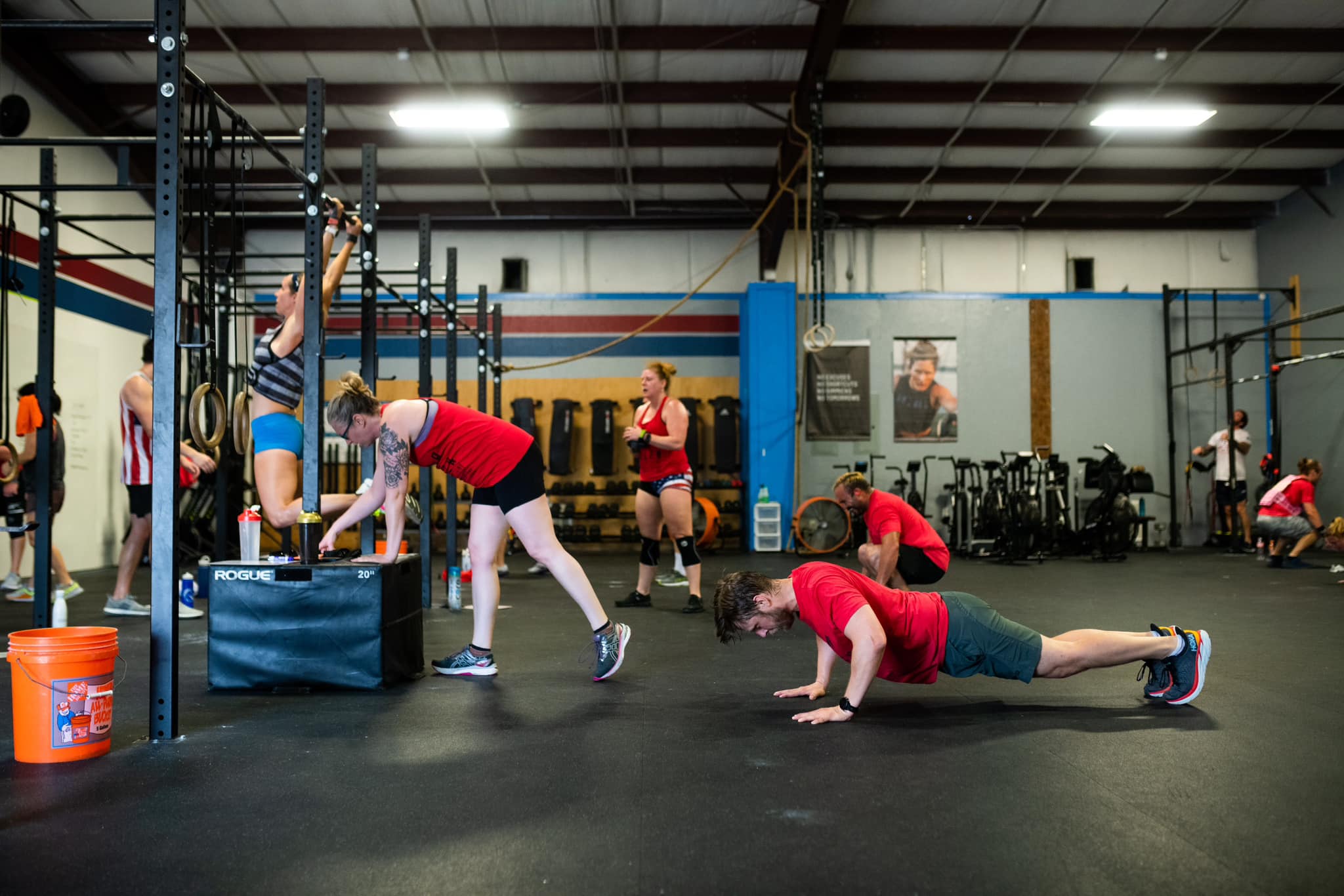Many beginners face concerns about tackling the Murph workout. They often worry about the sheer volume of exercises and the demanding nature of the conditioning. This plan aims to ease this apprehension by providing a structured, step-by-step approach to prepare you effectively for the Murph. This post will guide you through a 12-week program tailored to your needs, focusing on progressive overload and building stamina gradually, so you can achieve success in your Murph journey.
What is the Murph?
The Murph workout is a challenging CrossFit routine that honors fallen serviceman Lieutenant Michael Murphy. It consists of a one-mile run, 100 pull-ups, 200 push-ups, 300 squats, and another mile run, typically performed while wearing a weighted vest. This rigorous workout tests both strength and endurance, engaging multiple muscle groups and pushing athletes to their limits.
The workout consists of a specific sequence: pull-ups (or assisted pull-ups), push-ups (or knee push-ups), air squats, and a run (distance). The precise distance varies based on the specific event, but generally, the run is a significant factor in the total workout time. Realistic expectations are key; progress will take time and dedication to build up your strength and stamina.
The Murph workout’s popularity stems from its challenging nature and the strong sense of community and respect it fosters. It’s a test of your physical and mental fortitude, demanding a comprehensive approach to fitness encompassing strength, endurance, and agility. The workout’s demands should be approached thoughtfully, prioritizing a structured and safe training plan.
Your First Steps to Murph
Formulating SMART (Specific, Measurable, Achievable, Relevant, Time-bound) goals is crucial. For instance, aim for completing Murph within a specific time frame, performing a certain number of pull-ups, or running a particular distance. These concrete targets will keep you motivated and track your progress. You must prioritize a structured approach. A structured program will guarantee you don’t fall into a pattern that might lead to injury.
This program typically spans 12 weeks, providing a sufficient time frame to build your strength and endurance progressively. This time frame offers you a steady increase in intensity that’s vital for building up your fitness gradually, ensuring you’re not overexerting yourself or risking injury. It’s not a race but a journey of self-improvement.
Workouts should be spaced out, ensuring adequate rest days between sessions. Aim for 3-4 workouts per week, allowing for adequate rest and recovery. This schedule fosters consistency and prevents overtraining, a common pitfall for ambitious athletes. This is a vital part of the program, helping you avoid burn-out or injury. This structured frequency is crucial for your body to recover and rebuild muscle tissue effectively. Adequate rest days are critical for optimizing performance gains.
Week-by-Week Progression (Building Your Murph Strength)
Weeks 1-4 focus on establishing a foundation. Gradually increase the repetitions and duration of each exercise. Incorporate light cardio and ensure proper form takes precedence over intensity. A structured approach to progressively increase repetitions and duration for each exercise is essential to building your foundation. This avoids injury and optimizes training results.
Weeks 5-8 emphasize strength building. Introduce variations, like unassisted pull-ups or incline push-ups, gradually increasing intensity. Focus on compound movements to promote functional training and improve your overall strength. Adding compound exercises during this phase will make you more resilient and stronger.
Weeks 9-12 simulate the Murph workout. Increase run durations and exercise repetitions. Aim for full-body workouts, mimicking the Murph sequence and duration. Begin decreasing rest times between sets to enhance cardio endurance. The approach here is crucial; you need to mimic the demands of the Murph to prepare your body for the full event. You’ll develop greater endurance and stamina. This phase allows your body to adjust to the sustained effort required.
Beginner Murph Training Plan
Weeks 1-4
| Week | Focus | Run/Walk | Push-Ups | Air Squats | Pull-Ups/Assisted Rows | Frequency |
| Week 1 | Build the Basics | 400m | 2 sets of 8–10 reps | 2 sets of 12–15 reps | 2 sets of 5–8 reps | 3x per week |
| Week 2 | Increase Endurance | 600m | 3 sets of 8–10 reps | 3 sets of 12–15 reps | 2–3 sets of 5–8 reps | 3x per week |
| Week 3 | Gradual Progression | 800m | 3 sets of 10–12 reps | 3 sets of 15–18 reps | 3 sets of 6–8 reps | 3x per week |
| Week 4 | Strength and Stamina | 1000m | 4 sets of 10–12 reps | 4 sets of 15–18 reps | 3–4 sets of 6–8 reps | 3x per |
Weeks 5-8
| Week | Focus | Run/Walk | Push-Ups | Air Squats | Pull-Ups/Assisted Rows | Frequency |
| Week 5 | Strength and Stability | 1000m | 3–4 sets of 12–15 reps | 3 sets of 20 reps | 2 sets of unassisted pull-ups or 3–4 sets of assisted rows | 3x per week |
| Week 6 | Increase Pull-Up Strength | 1000m | 4 sets of 12–15 reps | 4 sets of 20 reps | 3 sets of unassisted pull-ups or 3–4 sets of assisted rows | 3x per week |
| Week 7 | Full-Body Strength Focus | 1200m | 4 sets of 15–18 reps | 4 sets of 20–25 reps | 3–4 sets of unassisted pull-ups | 3x per week |
| Week 8 | Compound Movements | 1200m | 4 sets of 15–20 reps | 4 sets of 25 reps | 4 sets of unassisted pull-ups or increase resistance for rows | 3x per week |
Weeks 9-12
| Week | Focus | Run | Push-Ups | Air Squats | Pull-Ups/Assisted Rows | Rest Time Between Sets | Frequency |
| Week 9 | Simulate Murph; Increase Intensity | 1600m (1 mile) | 4 sets of 18–20 reps | 4 sets of 25 reps | 4 sets of unassisted pull-ups or 4–5 sets of assisted rows | 1–2 min rest between sets | 4x per week |
| Week 10 | Focus on Full-Body Conditioning | 1600m (1 mile) | 5 sets of 18–20 reps | 5 sets of 25–30 reps | 4–5 sets of unassisted pull-ups | 1–2 min rest between sets | 4x per week |
| Week 11 | Increase Cardio & Full-Body Work | 2000m (1.25 miles) | 5 sets of 20–25 reps | 5 sets of 30 reps | 5 sets of unassisted pull-ups or 5–6 sets of assisted rows | 1 min rest between sets | 4x per week |
| Week 12 | Simulate Full Murph Workout | 2400m (1.5 miles) | 6 sets of 20–25 reps | 6 sets of 30 reps | 6 sets of unassisted pull-ups or 6–7 sets of assisted rows | 30 sec–1 min rest between sets | 4x per week |
Mastering Murph Movements
Proper pull-up technique involves a strong grip, controlled body positioning, and deliberate negative repetitions to maximize strength gains. Consistency in your form throughout the exercise will help build your strength. Effective technique is key; your body will respond better to the movements over time.
Focus on correct push-up form, emphasizing hand placement, chest engagement, and controlled body movement. Whether on hands or knees, maintaining proper form through this process is essential. Focus on proper form, which is fundamental to injury prevention and optimal performance.
For air squats, prioritize proper depth, posture, and core engagement. Consistent proper form during air squats will optimize the engagement of your muscles. Maintain proper posture during the entire exercise to optimize performance gains and prevent injury.
Running requires correct form, sufficient hydration, and pacing strategies. Implement interval training to improve endurance. Hydration is key for performance during long runs. The approach to your run should include strategic pacing to manage exertion and maintain endurance throughout the run.
Fueling Your Murph Journey
A balanced diet with adequate protein, carbohydrates, and healthy fats is essential for energy and recovery. This is fundamental to optimizing your body’s ability to repair and rebuild. Maintaining a balanced diet is crucial for ensuring your body has the resources to recover effectively. Optimal nutrition is key to both performance and recovery.
Adequate hydration before, during, and after workouts is critical. Drink plenty of water to support your body’s functions. Hydration ensures that your body has the necessary fluids for optimal function and performance during the workout. Consistently drinking plenty of water during and after exercise is essential for recovery.
Pre-workout snacks and post-workout meals help fuel your body and maximize muscle repair and growth. Careful planning and understanding of when you need fuel will give your body the best chance at recovery. This nutrition plan helps fuel your training, optimize recovery, and enhance performance.
Sufficient sleep is paramount to recovery. Rest and sleep are critical to physical and mental restoration. Adequate sleep allows your body to repair tissues and recover from your daily activities and training efforts. Sleep is essential for overall health and recovery.
Supplements may be beneficial, but they aren’t a necessity for a beginner program. Supplements can assist in achieving a healthy state of fitness, but should not be relied on to compensate for inadequate training or nutritional habits. You must ensure you are consuming a proper and healthy diet to support your fitness.
The Importance of Downtime
Rest days are essential for muscle repair and growth. Most athletes should aim for 1-3 rest days per week. A common approach is to follow a 3-on, 1-off training schedule, where you work out for three consecutive days followed by a rest day. Your body needs time to repair and rebuild muscle tissue, allowing you to progress steadily. Rest allows your body to recover and rebuild effectively, preparing you for the next training session.
Pay attention to any signs of overtraining, such as excessive fatigue or pain. Don’t push yourself too hard; listen to your body to avoid potentially serious injuries. Know when to push yourself and when to take a break.
Finding a Coach or Partner
A workout partner or coach can offer guidance, motivation, and accountability. Enlisting the support of others is a significant factor in your success. The support of a friend can motivate you, improve consistency, and enhance your overall fitness progress.
Explore local CrossFit gyms like Eximo Fitness or find certified coaches like me (Finn Carter) :> for personalized guidance and support. Look for CrossFit gyms with experienced instructors and a supportive community. This will create an environment that supports your fitness progress.
Online communities and forums provide resources for support, motivation, and encouragement from other fitness enthusiasts. Connecting with others on online forums and communities creates a sense of belonging and provides valuable support for your fitness journey. For my clients, I often recommend following inspirational accounts on Instagram, TikTok to stay motivated and connected with the fitness community.








